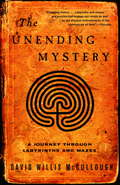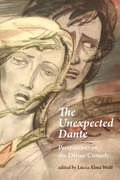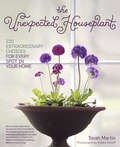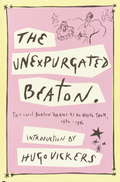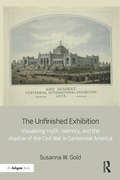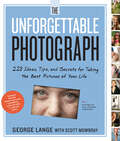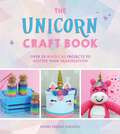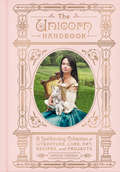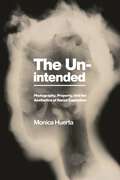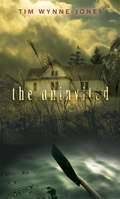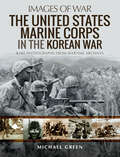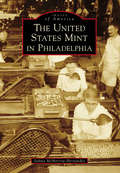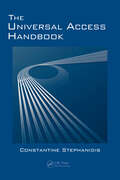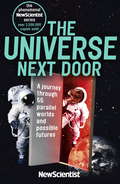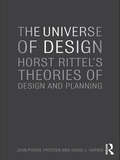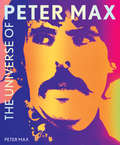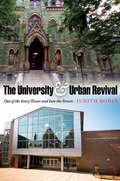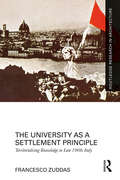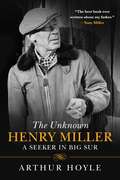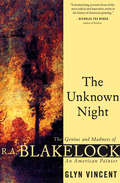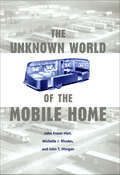- Table View
- List View
The Unending Mystery: A Journey Through Labyrinths and Mazes
by David Willis McculloughThe Unending Mystery is a charming, offbeat, generously illustrated exploration of a form that has had a place in the culture of almost every civilization since the beginning of human history--and is now experiencing a modern revival. Labyrinths appear on Neolithic rock outcroppings and in some of the oldest legends from the Greek Isles and the American Southwest. They have been created to represent everything from the birth of a child to the descent into hell, and legions of claims--from facilitating pregnancy to freeing souls from Purgatory--have been made for their power. In them we see perhaps the first human effort to create a form not found in nature, and we experience a mystery that has survived the millennia in countless manifestations. From the Mediterranean to Tuscany and Scandinavia, from English villages to French cathedrals and Italian palace gardens, David Willis McCullough takes us on a grand tour of the great labyrinths and mazes. Using a distinctive blend of history and research, he tells the story of their interpretations and uses, from the exalted to the ridiculous. He visits with today's labyrinth enthusiasts, including a Scotswoman who creates them in the South Bronx, the canon of San Francisco's Grace Cathedral who wants to pepper the world with them, and the showman who conceived the first cornfield maze--a phenomenon that is staving off bankruptcy for many American farmers. McCullough's infectious enthusiasm and wit make him the ideal guide to the age-old, ever-alluring world of labyrinths and mazes. From the Hardcover edition.
The Unexpected Dante: Perspectives on the Divine Comedy
by Francesco Ciabattoni Lucia Alma Wolf Bernardo Piciché Kristina M. Olson Sylvia Rodgers AlbroDante Alighieri’s long poem The Divine Comedy has been one of the foundational texts of European literature for over 700 years. Yet many mysteries still remain about the symbolism of this richly layered literary work, which has been interpreted in many different ways over the centuries. The Unexpected Dante brings together five leading scholars who offer fresh perspectives on the meanings and reception of The Divine Comedy. Some investigate Dante’s intentions by exploring the poem’s esoteric allusions to topics ranging from musical instruments to Roman law. Others examine the poem’s long afterlife and reception in the United States, with chapters showcasing new discoveries about Nicolaus de Laurentii’s 1481 edition of Commedia and the creative contemporary adaptations that have relocated Dante’s visions of heaven and hell to urban American settings. This study also includes a guide that showcases selected treasures from the extensive Dante collections at the Library of Congress, illustrating the depth and variety of The Divine Comedy’s global influence. The Unexpected Dante is thus a boon to both Dante scholars and aficionados of this literary masterpiece. Published by Bucknell University Press in association with the Library of Congress. Distributed worldwide by Rutgers University Press.
The Unexpected Houseplant: 220 Extraordinary Choices for Every Spot in Your Home
by Tovah MartinIt's time for plant lovers to dust off their houseplants, update their image, and discover just how exciting, trendy, and crucial plants can be in the home.The Unexpected Houseplant, by renowned plant authority Tovah Martin, isn't your typical, old-fashioned, dowdy houseplant book. Martin's approach is revolutionary—picture brilliant spring bulbs by the bed, lush perennials brought in from the garden, quirky succulents in the kitchen, even flowering vines and small trees growing beside an easy chair. Martin brings an evangelist's zeal to the task of convincing homeowners that indoor plants aren't just a luxury—they're a necessity. In addition to design flair, houseplants clean indoor air, which can be up to ten times more polluted. Along with loads of visual inspiration, readers will learn how to make unusual selections, where to best position plants in the home, and valuable tips on watering, feeding, grooming, pruning, and troubleshooting, season by season.
The Unexpurgated Beaton
by Cecil Beaton Hugo VickersCecil Beaton was one of the great twentieth-century tastemakers. A photographer, artist, writer and designer for more than fifty years, he was at the center of the worlds of fashion, society, theater and film. The Unexpurgated Beaton brings together for the first time the never-before-published diaries from 1970 to 1980 and, unlike the six slim volumes of diaries published during his lifetime, these have been left uniquely unedited. Hugo Vickers, the executor of Beaton's estate and the author of his acclaimed biography, has added extensive and fascinating notes that are as lively as the diary entries themselves. As one London reviewer wrote, "Vickers' waspish footnotes are the salt on the side of the dish." Beaton treated his other published diaries like his photographs, endlessly retouching them, but, for this volume, Vickers went back to the original manuscripts to find the unedited diaries. Here is the photographer for British and American Vogue, designer of the sets and costumes for the play and film My Fair Lady and the film Gigi, with a cast of characters from many worlds: Bianca Jagger, Greta Garbo, David Hockney, Truman Capote, the Queen Mother and Princess Margaret, Mae West, Elizabeth Taylor, Marlene Dietrich, Rose Kennedy and assorted Rothschilds, Phippses and Wrightsmans; in New York, San Francisco, Palm Beach, Rio and Greece, on the Amalfi coast; at shooting parties in the English countryside, on yachts, at garden parties at Buckingham Palace, at costume balls in Venice, Paris or London. Beaton had started as an outsider and "developed the power to observe, first with his nose pressed up against the glass," and then later from within inner circles. Vickers has said, "his eagle eye missed nothing," and his diaries are intuitive, malicious (he took a "relish in hating certain figures"), praising and awestruck. Truman Capote once said "the camera will never be invented that could capture or encompass all that he actually sees." The Unexpurgated Beaton is a book that is not only a great read and wicked fun but a timeless chronicle of our age.From the Hardcover edition.
The Unfinished Exhibition: Visualizing Myth, Memory, and the Shadow of the Civil War in Centennial America
by Susanna W. GoldThe Centennial decade was an era of ambivalence, the United States still unresolved about the incomprehensible damage it had wrought over four years of Civil War, and why. Philadelphia’s 1876 Centennial Exhibition -- a spectacular international event celebrating one hundred years of American strength, unity, and freedom -- took place in the immediate wake of this trauma of war and the failures of Reconstruction as a means to restore power and patriotism in the nation’s struggle to rebuild itself. The Unfinished Exhibition, the first comprehensive examination of American art at the Centennial, explains the critical role of visual culture in negotiating memories of the nation’s past that conflicted with the optimism that Exhibition officials promoted. Supporting novel iconographical interpretations with myriad primary source material, author Susanna W. Gold demonstrates how the art galleries and the audiences who visited them addressed the lingering traumas of battle, the uneasy re-unification of North and South, and the persisting racial tensions in the post-Emancipation era. This careful consideration of the visual record exposes the complexities of the war’s impact on Americans and clarifies how the Centennial art exhibition affected a nation still finding its direction at a critical moment in its history.
The Unforgettable Photograph: How to Take Great Pictures of the People and Things You Love
by George Lange Scott MowbrayRenowned photographer George Lange’s work is guided by one simple truth: An unforgettable photograph is not about what the subject looks like, but what it feels like. In this entirely new kind of photography guide, written by Mr. Lange and Scott Mowbray, magazine editor and longtime amateur photographer, the rest of us will learn how to take photographs that don’t just document life but celebrate it.No fancy equipment required. Just hundreds of simple, inspiring ideas and lessons—each one illustrated with a photograph—organized around the six essential principles of seeing like a photographer. (Here’s one: Shoot the Moment, Not the Subject.)Here’s why to shoot in natural light—always. The fun of putting babies in surprising places. How to get intimate with food. Using a dramatic sky as your backdrop. The benefit of learning to know the light in every room of your house. Shooting hands or feet instead of faces. How to move past the “I was here” postcard effect. How to catch the in-between moments. Because in the end, it’s about living the moment, shooting the moment—and being in the moment forever.
The Unicorn Craft Book: Over 25 Magical Projects to Inspire Your Imagination
by Isabel Urbina GallegoThe magical realm of unicorns comes to life in this dazzling craft book, brimming with sparkles and rainbows. Each project comes with a list of all the items and templates that you will need to create your unicorn-fuelled fun, along with step-by-step instructions and clear photographs to help you create something really special.
The Unicorn Craft Book: Over 25 Magical Projects to Inspire Your Imagination
by Isabel Urbina GallegoThe magical realm of unicorns comes to life in this dazzling craft book, brimming with sparkles and rainbows. Each project comes with a list of all the items and templates that you will need to create your unicorn-fuelled fun, along with step-by-step instructions and clear photographs to help you create something really special.
The Unicorn Handbook: A Spellbinding Collection of Literature, Lore, Art, Recipes, and Projects (The Enchanted Library)
by Carolyn TurgeonFrom Carolyn Turgeon, editor in chief of Enchanted Living and author of The Faerie Handbook and The Mermaid Handbook, comes this exquisitely illustrated and beautifully designed lifestyle compendium, a complete guide to the world of unicorns covering fashion and beauty; arts and culture; and home, food, and entertaining with step-by-step crafts and recipes.Strong, regal, and dazzling, there is no more romantic a creature in both folklore and pop culture than the majestic unicorn. Known for its preference for solitary living in the depths of enchanted and perfumed forests, the unicorn will only occasionally reveal itself to virginal ladies and/or save the day with its magical horn, which is said to neutralize poison when dipped into food or drink.In medieval times, unicorns were a symbol of chivalry and aristocracy, so it’s no surprise that they became the ideal companion for gallant knights, and eventually, the symbol of Jesus in many illuminated bestiaries. They also came to represent unknown danger in the ancient city of Persepolis in 515 BCE, a belief immortalized on the British coat of arms with the unicorn shown as the mighty lion’s fiercest opponent. This feud also appears in a traditional English nursery that was the origin of the quarrel between The Lion and the Unicorn in Lewis Carroll’s Through the Looking-Glass. It wasn’t long before a piece of the unicorn’s mane, blood, and horn became hot commodity in man’s pursuit for immortality. Today, unicorns can be found in modern tales like Harry Potter, television shows like My Little Pony, colorful Lisa Frank-inspired fashion and makeup trends, and must-have food crazes like the Unicorn Frappuccino and bagels. Divided into four sections: flora and fauna; fashion and beauty; arts and culture; home, food, and entertaining—The Unicorn Handbook is the ultimate compilation and guidebook filled with step-by-step projects and recipes throughout. Learn how to make your very own unicorn tail loop braid or unicorn dust for that extra sparkle in your life. There are recipes to make a plum cake straight from the world of Alice in Wonderland and tips on how to throw the most unique garden party ever (complete with instructions on how to make unicorn horn table favors and utensils). And there’s also an exclusive interview with Peter S. Beagle, the author of the classic tale The Last Unicorn.
The Unintended: Photography, Property, and the Aesthetics of Racial Capitalism (America and the Long 19th Century #26)
by Monica HuertaReimagines photography through the long history of ideas of expressionThe end of the nineteenth century saw massive developments and innovations in photography at a time when the forces of Western modernity—industrialization, racialization, and capitalism—were quickly reshaping the world. The Unintended slows down the moment in which the technology of photography seemed to speed itself—and so the history of racial capitalism—up. It follows the substantial shifts in the markets, mediums, and forms of photography during a legally murky period at the end of the nineteenth century. Monica Huerta traces the subtle and paradoxical ways legal thinking through photographic lenses reinscribed a particular aesthetics of whiteness in the very conceptions of property ownership. The book pulls together an archive that encompasses the histories of performance and portraiture alongside the legal, pursuing the logics by which property rights involving photographs are affirmed (or denied) in precedent-setting court cases and legal texts. Emphasizing the making of “expression” into property to focus our attention on the failures of control that cameras do not invent, but rather put new emphasis on, this book argues that designations of control’s absence are central to the practice and idea of property-making. The Unintended proposes that tracking and analyzing the sensed horizons of intention, control, autonomy, will, and volition offers another way into understanding how white supremacy functions. Ultimately, its unique historical reading practice offers a historically-specific vantage on the everyday workings of racial capitalism and the inheritances of white supremacy that structure so much of our lives.
The Uninvited
by Tim Wynne-JonesAfter a disturbing freshman year at New York University, Mimi is happy to get away to her father's remote Canadian cottage only to discover a stranger living there who has never heard of her or her father.
The United States Marine Corps in the Korean War: Rare Photographs From Wartime Archives (Images of War)
by Michael GreenThis pictorial history covers the US Marine Corps’ outstanding contribution, organization, tactics, fighting doctrine and weaponry during the Korean War.On June 25, 1950, the North Korean Army invaded South Korea. Among the US forces sent to South Korea was the 1st Marine Division. In September 1950, the Division audaciously landed deep behind enemy lines at Inchon port, throwing the North Korea Army into disarray.In November 1950, the Chinese Army invaded North Korea with eight divisions tasked with the destruction of the 1st Marine Division at the Chosin Reservoir. The Marines made a 78-mile fighting withdrawal in arctic conditions before being evacuated by the US Navy.In February 1951, the 1st Marine Division returned to combat assisting Eighth (US) Army to repulse five Chinese Army offensives over four months. By November 1951, the large-scale operations by the opposing sides had ended, replaced by a stalemate which lasted until the 27 July, 1953 armistice. With rare wartime images, this volume vividly chronicles the bitter three-year conflict.
The United States of Medievalism
by Tison Pugh and Susan AronsteinThe United States of Medievalism contemplates the desires, dreams, and contradictions inherent in experiencing the Middle Ages in a nation that is so temporally, spatially, and at times politically removed from them. The European Middle Ages have long influenced the national landscape of the United States through the medieval sites that permeate its self-announced republican landscapes and cities. Today, American-built medievalisms continue to shape the nation’s communities, collapsing the binaries between past and present, medieval and modern, European and American. The volume’s chapters visit the nation’s many medieval-inspired spaces, from Sherwood Forest in Texas to California’s San Andreas Fault. Stops are made in New York City’s churches, Boston’s gardens, Philadelphia’s Bryn Athyn Cathedral, Orlando’s Magic Kingdom, Appalachian highways, Minnesota’s Viking Villages, New Orleans’s Mardi Gras, and the Las Vegas Strip. As the editors and their fellow essayists take the reader on this cross-country trip across the United States, they ponder the cultural work done by the nation’s medievalized spaces. In its exploration of a seemingly distant period, this collection challenges the underexamined legacy of medievalism on the western side of the Atlantic. Full of intriguing case studies and reflections, this book is informative reading for anyone interested in the contemporary vestiges of the Middle Ages.
The Universal Access Handbook (Human Factors and Ergonomics)
by Constantine StephanidisIn recent years, the field of Universal Access has made significant progress in consolidating theoretical approaches, scientific methods and technologies, as well as in exploring new application domains. Increasingly, professionals in this rapidly maturing area require a comprehensive and multidisciplinary resource that addresses current principles
The Universe Next Door: A Journey Through 55 Parallel Worlds and Possible Futures
by New ScientistIt's lucky you're here. But for a series of choices, accidents and coincidences - any of which could have gone otherwise - your life would have been very different. The same goes for reality. We live in just one of many possible worlds - but we can imagine parallel universes in which dinosaurs still rule the Earth, the Russians got to the moon first, everyone's a vegetarian or time itself flows backwards. And that's just for starters. What if the laws of physics were different? What if robots become smarter than us? Or, if every human on the planet simply vanished tomorrow? The answers to these questions aren't just fun to consider, but reveal deep truths about our own universe.Join New Scientist on a thrilling journey through dozens of incredible but perfectly possible alternative realities, thought experiments and counterfactual histories - each shining a surprising and unexpected spotlight on life as we know it.
The Universe of Design: Horst Rittel's Theories of Design and Planning
by Jean-Pierre Protzen David J. HarrisThis book examines the theoretical foundations of the processes of planning and design. When people – alone or in groups – want to solve problems or improve their situation, they make plans. Horst Rittel studied this process of making plans and he developed theories – including his notion of "wicked problems" – that are used in many fields today. From product design, architecture and planning – where Rittel’s work was originally developed – to governmental agencies, business schools and software design, Rittel’s ideas are being used. This book collects previously unavailable work of Rittel’s within the framework of a discussion of Rittel’s theories and philosophical influences.
The Universe of Peter Max
by Peter MaxAn in-depth look at the personal and artistic life of renowned artist Peter Max...in his own wordsIn this intimate visual memoir, artist Peter Max details his life journey as an artist, providing a stirring account of himself as a young boy and as a successful artist eager to return to the days of wonderment and inspiration found only in dreams and childhood. Max charts his ascension in the art world and pauses to reflect on the nature of creativity, the universe at large, his many loves, and his ability to see beauty in the everyday. Vibrantly illustrated with Max's signature work, including some never-before-seen pieces, this colorful memoir reveals the personal inspiration behind the work of one of the world's most popular artists.With 200 full-color photographs
The University and Urban Revival
by Judith RodinIn the last quarter of the twentieth century, urban colleges and universities found themselves enveloped by the poverty, crime, and physical decline that afflicted American cities. Some institutions turned inward, trying to insulate themselves rather than address the problems in their own backyards. Others attempted to develop better community relations, though changes were hard to sustain.Spurred by an unprecedented crime wave in 1996, University of Pennsylvania President Judith Rodin knew that the time for urgent action had arrived, and she set a new course of proactive community engagement for her university. Her dedication to the revitalization of West Philadelphia was guided by her role not only as president but also as a woman and a mother with a deep affection for her hometown.The goal was to build capacity back into a severely distressed inner-city neighborhood--educational capacity, retail capacity, quality-of-life capacity, and especially economic capacity--guided by the belief that "town and gown" could unite as one richly diverse community.Cities rely on their academic institutions as stable places of employment, cultural centers, civic partners, and concentrated populations of consumers for local business and services. And a competitive university demands a vibrant neighborhood to meet the needs of its faculty, staff, and students. In keeping with their mission, urban universities are uniquely positioned to lead their communities in revitalization efforts, yet this effort requires resolute persistence.During Rodin's administration (1994-2004), the Chronicle of Higher Education referred to Penn's progress as a "national model of constructive town-gown interaction and partnership." This book narrates the challenges, frustrations, and successes of Penn's campaign, and its prospects for long-term change.
The University as a Settlement Principle: Territorialising Knowledge in Late 1960s Italy (Routledge Research in Architecture)
by Francesco ZuddasThe 1960s and the 1970s marked a generational shift in architectural discourse at a time when the revolts inside universities condemned the academic institution as a major force behind the perpetuation of a controlling society. Focusing on the crisis and reform of higher education in Italy, The University as a Settlement Principle investigates how university design became a lens for architects to interpret a complex historical moment that was marked by the construction of an unprecedented number of new campuses worldwide. Implicitly drawing parallels with the contemporary condition of the university under a regime of knowledge commodification, it reviews the vision proposed by architects such as Vittorio Gregotti, Giuseppe Samonà, Archizoom, Giancarlo De Carlo, and Guido Canella, among others, to challenge the university as a bureaucratic and self-contained entity, and defend, instead, the role of higher education as an agent for restructuring vast territories. Through their projects, the book discusses a most fertile and heroic moment of Italian architectural discourse and argues for a reconsideration of architecture’s obligation to question the status quo. This work will be of interest to postgraduate researchers and academics in architectural theory and history, campus design, planning theory, and history.
The University of Illinois Memorial Stadium: The First 100 Years
by Kevin Hinders Benjamin BrossThis book offers a rigorous but graphically compelling narrative historic analysis of one of the most important civic buildings not only of the University of Illinois Urbana-Champaign, or the State of Illinois, but arguably of the United States, Memorial Stadium.Like all spatial products, the design and construction of the University of Illinois Memorial Stadium embodies the social, political, economic, aspiration, and aesthetic values of its time. This book will engage in critical analysis including documenting the civic discourse that led to the Stadium and thereafter explore the iterative nature of the Stadium in shaping civic discourse. In this vein, central topics include its role in embodying the state’s economic growth; the changing nature of the sociocultural tendencies and its impact on campus life and the University’s community; the Stadium’s effects on UIUC sports and the campus’ built environment; the rise of College sports as big business; and the impact on mass culture across the State and the country, like the use of stadiums as concert venues and place of public discourse. More than a simple study of the building’s conceptualization, design, and construction, this book reveals why Illinois’ Memorial Stadium is an iconic part of the American Midwest’s built landscape and in many ways part of the American mythic landscape.This will be interesting reading for all those familiar with the building, as well as all students and scholars of sports architecture.
The Unknown Henry Miller: A Seeker in Big Sur
by Arthur HoyleHenry Miller was one of the most distinctive voices in twentieth-century literature. Better known in Europe than in his native America for most of this career, he achieved international success and celebrity during the 1960s when his banned "Paris" books-beginning with Tropic of Cancer-were published here and judged by the Supreme Court not to be obscene. Until then he had toiled in relative obscurity and poverty. The Unknown Henry Miller recounts Miller's career from its beginnings in Paris in the 1930s but focuses on his years living in Big Sur, California, from 1944 to 1961, during which he wrote many of his most important books, including The Rosy Crucifixion trilogy, married and divorced twice, raised two children, painted watercolors, and tried to live out an aesthetic and personal credo of self-realization.Written with the cooperation of the Henry Miller, Anais Nin, and other estates, The Unknown Henry Miller quotes extensively from Miller's correspondence in order to offer the reader direct experience of the author and man. It also draws on material not available to previous biographers, including interviews with Lepska Warren, Miller's third wife, and revelations from unpublished portions of Anais Nin's diaries. Behind the "bad boy" image, the author finds a man with devoted friendships, whose challenge of literary sexual taboos was part of a broader assault on the dehumanization of man and commercialization during the postwar years. He puts Miller's alleged misogyny in the context of his satire of sexual mores in general, and makes the case for restoring this groundbreaking writer to his rightful place in the American literary canon.
The Unknown Night: The Genius and Madness of R. A. Blakelock, an American Painter
by Glyn VincentOn February 22, 1916, Ralph Albert Blakelock's haunting landscape, Brook by Moonlight, was sold at auction for $20,000, a record price for a painting by a living American artist. The sale made him famous, newspapers called him America's greatest artist, and thousands flocked to exhibits of his work. Yet at the time of his triumph Blakelock had spent 15 years confined in a psychiatric hospital in upstate New York and his wife and children were living in poverty. Released from the asylum by a young philanthropist, Blakelock was about to become the victim of one of the most heartless con games of the century.This remarkable biography chronicles the life, times and madness of one of America’s most celebrated and exploited painters whose brooding, hallucinogenic landscapes anticipated Abstract Expressionism by more than half a century. Like the best biographies, The Unknown Night brings to life a vanished world, as well. In this case, it’s late 19th and early 20th century New York a city of artists’ studios and spiritualists’ salons, shantytowns and millionaires’ mansions.Blakelock was a mystic who as a young man wandered among the Indians out West, and on his return frequented the spiritualist circles in New York City. Though he was regarded as a loner, he worked among the great painters of his time, artists like William Merritt Chase and George Inness. Blakelock initially painted in the Romantic style of the Hudson River School, but by the 1880s, his brooding, hallucinogenic landscapes were considered among the most controversial, radical paintings of the era. In the 1890s he fell on hard times and sometimes played the piano on the vaudeville circuit to earn extra cash. He suffered his first mental break down in 1891. After a period of remission he became violent and was institutionalized in 1899 just as his reputation was beginning to soar. Interest in his work peaked in 1916 when a wave of Blakelock hysteria swept America. Crowds lined up to see Blakelock exhibitions in New York, Chicago and San Francisco. Wealthy collectors bid record prices for his haunting paintings. Blakelock was released from the asylum and seemed destined for a glorious and comfortable end. Instead, fed upon by opportunistic dealers and forgers, Blakelock became entangled in a web of deceit spun by the very woman who was supposed to be his savior.Vincent begins his story in the spring of 1916 when Blakelock's canvas, The Brook by Moonlight, was auctioned at the Plaza Hotel in New York for $20,000 - a record price at that time for the work of a living American painter. It was Blakelock's second record in three years. Newspaper reporters converged on the painter and art pundits tripped over each other in doling out praise for his mysterious nocturnal landscapes. Few American artists deserve a higher niche in the Temple of Fame, drooled the pioneering art dealer, William Macbeth. Some were calling Blakelock the greatest American landscape painter ever.At the time, Blakelock was penniless, a resident of an asylum in Middletown, New York. His wife, Cora Bailey Blakelock was living in poverty with their youngest children in a small house in the Catskills. Blakelock may well have remained locked away if it had not been for the efforts of Mrs. Van Rensselaer Adams, a 32-year-old vamp with a shady past. Adams passed herself off as a philanthropist, rescued Blakelock from the asylum, and brought him to New York City to generate public sympathy for the artist and his family. She had arranged a large show of his paintings at the Reinhardt Gallery on Fifth Avenue. It was a huge success attracting all the major critics and large crowds throughout its run over seven months. A committee of venerable art personages was formed to collect the proceeds from Blakelock’s work to be passed on to his wife and children. Blakelock, all dressed up for the Gallery opening, cut a dashing figure. His wife, though, was nowhere to be seen....
The Unknown World of the Mobile Home (Creating the North American Landscape)
by John Fraser Hart Michelle J. Rhodes John T. MorganIn American popular imagination, the mobile home evokes images of cramped interiors, cheap materials, and occupants too poor or unsavory to live anywhere else. Since the 1940s and '50s, however, mobile home manufacturers have improved standards of construction and now present them as an affordable alternative to conventional site-built homes. Today one of every fourteen Americans lives in a mobile home. In The Unknown World of the Mobile Home authors John Fraser Hart, Michelle J. Rhodes, and John T. Morgan illuminate the history and culture of these often misunderstood domiciles. They describe early mobile homes, which were trailers designed to be pulled behind automobiles and which were more often than not poorly constructed and unequal to the needs of those who used them. During the 1970s, however, Congress enacted federal standards for the quality and safety of mobile homes, which led to innovation in design and the production of much more attractive and durable models. These models now comply with local building codes and many are designed to look like conventional houses. As a result, one out every five new single-family housing units purchased in the United States is a mobile home, sited everywhere from the conventional trailer park to custom-designed "estates" aimed at young couples and retirees. Despite all these changes in manufacture and design, even the most immobile mobile homes are still sold, financed, regulated, and taxed as vehicles.With a wealth of detail and illustrations, The Unknown World of the Mobile Home provides readers with an in-depth look into this variation on the American dream.
The Unknown World of the Mobile Home (Creating the North American Landscape)
by John Fraser Hart Michelle J Rhodes John T MorganAn in-depth look at the history and culture of mobile homes in the United States.In American popular imagination, the mobile home evokes images of cramped interiors, cheap materials, and occupants too poor or unsavory to live anywhere else. Since the 1940s and ‘50s, however, mobile home manufacturers have improved standards of construction and now present them as an affordable alternative to conventional site-built homes. Today one of every fourteen Americans lives in a mobile home.In The Unknown World of the Mobile Home authors John Fraser Hart, Michelle J. Rhodes, and John T. Morgan illuminate the history and culture of these often misunderstood domiciles. They describe early mobile homes, which were trailers designed to be pulled behind automobiles and which were more often than not poorly constructed and unequal to the needs of those who used them. During the 1970s, however, Congress enacted federal standards for the quality and safety of mobile homes, which led to innovation in design and the production of much more attractive and durable models. These models now comply with local building codes and many are designed to look like conventional houses. As a result, one out every five new single-family housing units purchased in the United States is a mobile home, sited everywhere from the conventional trailer park to custom-designed “estates” aimed at young couples and retirees. Despite all these changes in manufacture and design, even the most immobile mobile homes are still sold, financed, regulated, and taxed as vehicles.With a wealth of detail and illustrations, The Unknown World of the Mobile Home provides readers with an in-depth look into this variation on the American dream.“A clear, concise, and innovative look at the history, the economics, and the politics of the mobile home. The authors reveal the inner workings of mobile home living by drawing upon a wide variety of sources, from industry data to interviews conducted at mobile home parks across the country. Further, they explore new types of mobile home communities—those assembled for workers at meat-processing centers in southwest Kansas, for example—that complicate the familiar image of the mobile home park as retirement village. The ideas presented in this book provide a solid starting point for many detailed studies on this important topic.” —Karl Raitz, University of Kentucky, author of The National Road
